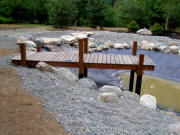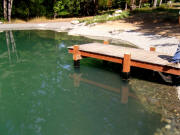Benefits of Polyurea
Pure Polyurea is a high performance, sprayed, plural
component elastomer exhibiting excellent physical properties.
Polyurea is based on amine-terminated polyether resins, amine
chain extenders and prepolymers. Polyurea provides an extremely
flexible, resilient, tough, monolithic membrane with excellent
water and chemical resistance.
Polyurea has an extremely long service life. Independent tests
commissioned by the Bechtel Corporation indicate at least 75
years.
Polyurea water containment is presently being built on the
Hanford Nuclear Reservation Tank Farm to avoid environmental
catastrophe. The tank farm has approximately 172 nuclear waste
storage tanks holding more than 50 million gallons of highly
radioactive waste materials. Polyurea is chosen to accomplish
the most critical water containment projects in the world.
Polyurea has a high puncture & impact resistance far exceeding
EPDM liners. Refer to military tests & implementation of
Polyurea as a medium for blast mitigation.
Polyurea HI-E exhibits 700% elongation which allows for various
ground movement, such as, swelling, subsidence, seismic activity
& freeze/thaw cycles. When combined with geo-textile fabric &
applied to the support structures it adds strength & ties
together the entire surface.
This elongation potential effectively mitigates the damaging
effects that concrete is so prone to.
Polyurea affords a completely seamless water proofing barrier
which will prevent leaching in either direction from support
structures such as concrete & chemically treated wood.
See thumbnails below.
Polyurea liners are built, in situ, as a continuous unit,
creating one continuous molecular chain. The completed Polyurea
liner is a single piece, an example of monocoque construction.
This seamless construction, with Polyurea’s extremely low rate
of permeability, effectively seals water from all submerged
structures such as docks, pillars & islands. As a result, these
structures will not be impacted overtime by the effects of
water. This level of protection results in decreased or non
existent long term maintenance.
EPDM liners require cutting & seaming around shapes & underwater
structures. This cutting & seaming compromises the long term
water tight integrity while relying on the glue bond of each
seam to determine the life of the liner. Polyurea is seamless.
Beach sand surfaces can be permanently affixed. Sand & gravel
may be broadcast into the polyurea immediately upon curing for a
natural sand finish.
A Polyurea liner requires much less concrete for structural
support than EPDM liners because the floor of the project can be
bare ground lined with Polyurea applied to geo-textile fabric.
These liners have been laboratory tested & found to yield
tensile strength values averaging 2500 psi.
Concrete naturally leaches into the water increasing both PH &
alkalinity over months & possibly years. In live water systems
this must be dealt with to maintain health & water quality
standards. Polyurea effectively isolates the cement with an
inert, impermeable membrane.
 |
 |
|
|
|
